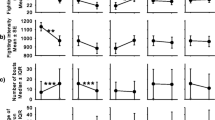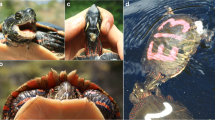Abstract
Studies of mating contests have reported how traits (e.g. body size) related to resource-holding potential (RHP) and strategies to assess RHP and resource value influence contest outcome in many taxa but are rare in the Gastropoda. The influence of male size (as an index of RHP) and female size (as a measure of resource value) on contest outcome was investigated in two littorinid snails, Echinolittorina malaccana and E. radiata, in Hong Kong during May–June 2013. In these snails, contests between males take the form of a ‘challenger’ attempting to take over the copulation position occupied by a ‘defender’. Both challengers and defenders were, generally, smaller than the females in both species. In both species, the larger the challenger relative to the defender, the more likely he would replace the defender in the copulation position. The challengers were, however, more successful in E. radiata, as they generally challenged defenders that were smaller than themselves, suggesting an ability to detect rival size before entering into a contest in this species. When sizes of the contestants were similar, defenders were more likely to win contests in E. malaccana but not in E. radiata. Evidence for pure self-assessment of RHP and the ability to assess resource value in challengers was found in E. malaccana. Different fighting strategies appear to have evolved in these congeneric marine snail species, and decisions based on male and female sizes play an important role in determining male reproductive success.





Similar content being viewed by others
References
Andersson M (1994) Sexual selection. Princeton University Press, Princeton
Arnott G, Elwood RW (2008) Information gathering and decision making about resource value in animal contests. Anim Behav 76:529–542
Arnott G, Elwood RW (2009) Assessment of fighting ability in animal contests. Anim Behav 77:991–1004
Bradshaw-Hawkins VI, Sander F (1981) Notes on the reproductive biology and behavior of the West Indian fighting conch Strombus pugilis Linnaeus in Barbados with evidence of mate guarding. Veliger 24:159–164
Briffa M, Hardy ICW, Gammell MP, Jennings DJ, Clarke DD, Goubault M (2013) Analysis of animal contest data. In: Hardy ICW, Briffa M (eds) Animal contests. Cambridge University Press, Cambridge, pp 47–85
Dick JTA, Elwood RW (1990) Symmetrical assessment of female quality by male Gammarus pulex (Amphipoda) during struggles over precopula females. Anim Behav 40:877–883
Elwood RW, Pothanikat RME, Briffa M (2006) Honest and dishonest displays, motivational state and subsequent decisions in hermit crab shell fights. Anim Behav 72:853–859
Emlen DJ (2008) The evolution of animal weapons. Annu Rev Ecol Evol Syst 39:387–413
Erlandsson J, Johannesson K (1994) Sexual selection on female size in a marine snail, Littorina littorea (L.). J Exp Mar Biol Ecol 181:145–157
Erlandsson J, Kostylev V (1995) Trail following speed and fractal dimension of movement in a marine prosobranch Littorina littorea during a mating and a non-mating season. Mar Biol 122:87–94
Gibson DG (1965) Mating behaviour in Littorina planaxis Philippi (Gastropoda: Prosobranchiata). Veliger 7:134–139
Hardy ICW, Briffa M (2013) Animal contests. Cambridge University Press, Cambridge
Johannesson K, Havenhand JN, Jonsson PR, Lindegarth M, Sundin A, Hollander J (2008) Male discrimination of female mucus trails permits assortative mating in a marine snail species. Evolution 62:3178–3184
Johannesson K, Saltin SH, Duranovic I, Havenhand JN, Jonsson PR (2010) Indiscriminate males: mating behaviour of a marine snail compromised by a sexual conflict? PLoS One 5:e12005
Kokko H, Lopez-Sepulcre A, Morrell LJ (2006) From hawks and doves to self-consistent games of territorial behavior. Am Nat 167:901–912
Mak YM (1996) The ecology of the high-zoned littorinids Nodilittorina trochoides N radiata and N vidua on rocky shores in Hong Kong. PhD thesis, The University of Hong Kong, Hong Kong
Mak YM, Williams GA (1999) Littorinids control high intertidal biofilm abundance on tropical Hong Kong rocky shores. J Exp Mar Biol Ecol 233:81–94
Marshall DJ, McQuaid CD, Williams GA (2010) Non-climatic thermal adaptation: implications for species’ responses to climate warming. Biol Lett 6:669–673
McQuaid CD (1996) Biology of the gastropod family Littorinidae. II. Role in the ecology of intertidal and shallow marine ecosystems. Oceanogr Mar Biol Ann Rev 34:263–302
Moore JC, Obbard DJ, Reuter C, West SA, Cook JM (2008) Fighting strategies in two species of fig wasp. Anim Behav 76:315–322
Morrell LJ, Backwell PRY, Metcalfe NB (2005) Fighting in fiddler crabs Uca mjoebergi: what determines duration? Anim Behav 70:653–662
Ng TPT (2013) Reproductive traits and sexual selection in the mangrove littorinid snails Littoraria ardouiniana and L melanostoma. PhD thesis, The University of Hong Kong, Hong Kong
Ng TPT, Williams GA (2012) Contrasting reproductive traits in two species of mangrove-dwelling littorinid snails in a seasonal tropical habitat. Invert Biol 131:177–186
Ng TPT, Williams GA (2014) Size-dependent male mate preference and its association with size-assortative mating in a mangrove snail, Littoraria ardouiniana. Ethology 120:995–1002
Ng TPT, Davies MS, Stafford R, Williams GA (2011) Mucus trail following as a mate-searching strategy in mangrove littorinid snails. Anim Behav 82:459–465
Ng TPT, Saltin SH, Davies MS, Johannesson K, Stafford R, Williams GA (2013) Snails and their trails: the multiple functions of trail-following in gastropods. Biol Rev 88:683–700
Parker GA (1974) Assessment strategy and the evolution of fighting behaviour. J Theor Biol 47:223–243
Prenter J, Elwood RW, Taylor PW (2006) Self-assessment by males during energetically costly contests over precopula females in amphipods. Anim Behav 72:861–868
Reid DG (1986) The littorinid molluscs of mangrove forests in the Indo-Pacific region: the genus Littoraria. British Museum (Natural History), London
Reid DG (1989) The comparative morphology phylogeny and evolution of the gastropod family Littorinidae. Philos Trans R Soc B 324:1–110
Reid DG, Dyal P, Williams ST (2012) A global molecular phylogeny of 147 periwinkle species (Gastropoda Littorininae). Zool Scr 41:125–136
Saltin SH, Schade H, Johannesson K (2013) Preference of males for large females causes a partial mating barrier between a large and a small ecotype of Littorina fabalis (W Turton 1825). J Molluscan Stud 79:128–132
Seyer J-O (1992) Resolution and sensitivity in the eye of the winkle Littorina littorea. J Exp Biol 170:57–69
Simmons LW (1986) Inter-male competition and mating success in the field cricket Gryllus bimaculatus (De Geer). Anim Behav 34:567–579
Stafford R, Davies MS, Williams GA (2007) Computer simulations of high shore littorinids predict small-scale spatial and temporal distribution patterns on real rocky shores. Mar Ecol Prog Ser 342:151–161
Stafford R, Davies MS, Williams GA (2008) Self-organization of intertidal snails facilitates evolution of aggregation behavior. Artif Life 14:409–423
Stafford R, Davies MS, Williams GA (2012) Cheats in a cooperative behaviour? Behavioural differences and breakdown of cooperative behaviour in aggregating littorinids. Mar Ecol 33:66–74
Stuart-Fox DM, Firth D, Moussalli A, Whiting MJ (2006) Multiple signals in chameleon contests: designing and analysing animal contests as a tournament. Anim Behav 71:1263–1271
Taylor PW, Elwood RW (2003) The mismeasure of animal contests. Anim Behav 65:1195–1202
Ward PI (1983) Advantages and disadvantages of large size for male Gammarus pulex. Behav Ecol Sociobiol 14:69–78
Williams GA (1994) Grazing by high-shore littorinids on a moderately exposed tropical rocky shore. In: Morton B (ed) The malacofauna of Hong Kong and Southern China III: proceedings of the third international workshop on the Malacofauna of Hong Kong and Southern China. Hong Kong University Press, Hong Kong, pp 379–389
Williams GA, Morrittt D (1995) Habitat partitioning and thermal tolerance in a tropical limpet, Cellana grata. Mar Ecol Prog Ser 124:89–103
Zahradnik TD, Lemay MA, Boulding EG (2008) Choosy males in a littorinid gastropod: male Littorina subrotundata prefer large and virgin females. J Molluscan Stud 74:245–251
Acknowledgments
Permission to work at the Cape d’ Aguilar Marine Reserve was granted by the Agriculture, Fisheries and Conservation Department of the Hong Kong SAR Government (Permit No.: (143) in AF GR MPA 01/5/2 Pt.13). Two reviewers are thanked for providing valuable comments and suggestions on the manuscript. We also thank Ms Cecily Law, The Swire Institute of Marine Science, HKU, for technical support.
Author information
Authors and Affiliations
Corresponding author
Additional information
Responsible Editor: J. Grassle.
Reviewed by J. H. Christy and an undisclosed expert.
Electronic supplementary material
Below is the link to the electronic supplementary material.
S1 Mating contest in E. malaccana. Challenger (top of the mating pair) ‘aggressively’ pushes, using his snout and an ‘up and down’ movement of his shell lip, at the foot of the defender (attached lower, right-hand side of female), to push the defender away and mate with the female. Video is 4x normal speed (WMV 24738 kb)
S2 Mating contest in E. radiata. Challenger (top of the mating pair) pushes using his snout at the foot of the defender (attached lower right-hand side of female) to push the defender away and mate with the female. Following this contest, another challenger pushes the first, successful, challenger away and replaces him to mate with the female. Video is 4x normal speed (WMV 20060 kb)
Rights and permissions
About this article
Cite this article
Ng, T.P.T., Davies, M.S., Stafford, R. et al. Fighting for mates: the importance of individual size in mating contests in rocky shore littorinids. Mar Biol 163, 50 (2016). https://doi.org/10.1007/s00227-016-2824-z
Received:
Accepted:
Published:
DOI: https://doi.org/10.1007/s00227-016-2824-z




